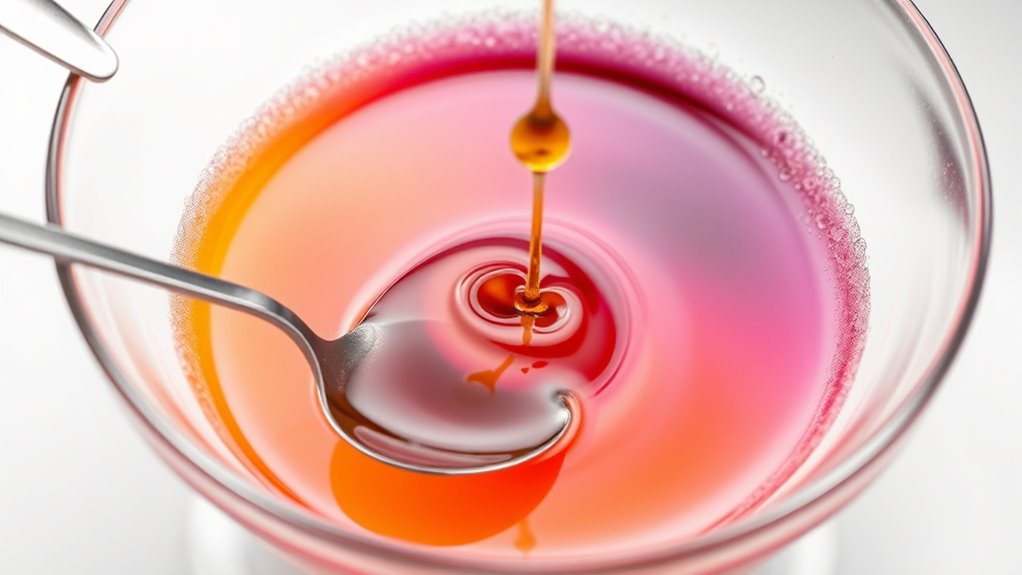When choosing between stir, swirl, or spoon, consider your specific needs. Stirring provides quick, thorough mixing ideal for uniform reactions, while swirling creates gentle vortexes perfect for delicate liquids. Spoon agitation offers precise control for small or sensitive samples. Each method serves different purposes, and understanding their differences helps you optimize your process. Keep exploring to discover the best techniques for your mixing tasks and achieve better results.
Key Takeaways
- Stirring provides thorough, quick mixing ideal for uniform reactions and large-scale processes.
- Swirling creates gentle, vortex-like mixing suitable for delicate liquids with minimal turbulence.
- Spoon agitation allows precise, manual control for small quantities and sensitive substances.
- Choice depends on substance properties and desired mixing intensity or gentleness.
- Mastering each method ensures optimal homogeneity and process efficiency.

Have you ever wondered how agitation methods are used to mix or process substances effectively? Whether you’re in a lab, a kitchen, or a manufacturing setting, understanding how different agitation techniques influence chemical reactions and mixing efficiency is key to achieving the desired results. When you stir, swirl, or spoon, you’re not just moving ingredients around—you’re controlling the way molecules interact, which can markedly impact the speed and completeness of chemical reactions.
Stirring is one of the most common and straightforward agitation methods. When you stir, you’re actively rotating a tool, like a spoon or a paddle, to create a consistent flow within the mixture. This movement helps disperse particles evenly, promoting uniformity and preventing separation. In chemical processes, stirring enhances mixing efficiency by increasing contact between reactants, ensuring they interact more quickly and thoroughly. This is particularly essential in reactions sensitive to concentration gradients or temperature variations. A well-stirred mixture reduces the risk of localized hot spots or unreacted pockets, leading to more predictable and efficient chemical reactions.
Stirring creates uniform mixtures by promoting contact between reactants and preventing separation.
Swirling, on the other hand, involves creating a circular motion, often with a gentle or controlled flow. When you swirl a container, you’re inducing a centrifugal force that keeps the mixture moving in a vortex. This method is especially useful for mixing liquids with different densities or viscosities, as it encourages rapid homogenization without the turbulence of vigorous stirring. Swirling can improve mixing efficiency by quickly uniformizing ingredients while minimizing splashing or splattering. In laboratory or culinary contexts, swirling is often preferred for delicate liquids or when you want to combine components gently, preserving their integrity while still ensuring effective mixing.
Using a spoon might seem simple, but it can be surprisingly effective, especially in small-scale or manual processes. When you spoon ingredients, you’re applying precise, targeted agitation. This method allows for careful control, which is indispensable when working with sensitive substances or when you need to mix gently to avoid damaging delicate structures. While spooning may not always be the fastest way to achieve thorough mixing, it can enhance mixing efficiency in specific applications where gentle agitation is needed to optimize chemical reactions or preserve the quality of the materials involved. Additionally, the tactile feedback from spooning can help monitor the texture and consistency of mixtures more closely.
In essence, each agitation method—stirring, swirling, or spooning—has its unique advantages and ideal applications. Your choice depends on what you’re working with and the level of mixing efficiency required. Mastering these techniques allows you to control chemical reactions more precisely, ensuring that your mixtures are homogeneous and your processes are as efficient as possible. Understanding the appropriate agitation method for your specific task can make a significant difference in achieving optimal results.
Frequently Asked Questions
Which Agitation Method Is Best for Delicate Ingredients?
For delicate ingredients, gentle mixing is your best choice. It minimizes the risk of damage or breaking apart fragile items. Rapid agitation can be too harsh, causing unintended effects. Instead, opt for slow, careful movements that evenly distribute ingredients without stressing them. Using a spoon or a gentle stir guarantees your delicate ingredients stay intact, preserving their texture and appearance while achieving a well-mixed result with minimal disruption.
How Does Temperature Affect Different Agitation Techniques?
Temperature control considerably impacts agitation techniques because heat transfer varies with each method. When you use gentle stirring, heat transfers slowly, preventing overheating delicate ingredients. Swirling promotes quicker heat transfer, making it ideal for even cooking or cooling. Spoons offer precise agitation, allowing you to manage temperature effects carefully. Adjust your technique based on the desired temperature stability and heat transfer rate, ensuring ideal results for your recipe.
Can Agitation Methods Influence Flavor Extraction?
Yes, agitation methods can influence flavor extraction by enhancing solubility, improving ingredient consistency, and increasing contact between components. When you stir, swirl, or spoon, you actively promote solubility enhancement, evenly distribute flavors, and guarantee ingredient consistency. These techniques help extract more aroma and taste, making your beverage or dish more flavorful. The right agitation method optimizes flavor extraction, giving you a richer, more balanced experience with every sip or bite.
Are There Specific Tools Recommended for Each Technique?
For stirring, you can use a regular spoon or a specialized whisk to control the agitation better. Swirling often requires gentle, circular motions with a handheld blender for quick, consistent results. Spoons are ideal for spooning or gentle mixing. Handheld blenders are recommended for swirling and more vigorous agitation, while specialized whisks are perfect for delicate stirring. Choose tools based on the intensity and precision needed for each technique.
How Do Agitation Methods Impact Cooking Time?
Agitation methods directly impact cooking efficiency and ingredient dispersion. When you stir or swirl, you promote uniform heat distribution and faster cooking, reducing overall time. Using a spoon allows precise control, ensuring ingredients are evenly dispersed without overmixing. If you choose the right method for your dish, you’ll notice improved cooking speed and better ingredient integration, making your process more efficient and your results more consistent.
Conclusion
No matter which agitation method you choose—stir, swirl, or spoon—each brings its own rhythm to your process. Think of them as dance partners guiding your mixture to perfection. Sometimes, a gentle swirl is all you need; other times, a firm spoon action gets the job done. Trust your instincts and the feel of your ingredients. After all, mastering these techniques is like tuning an instrument—your perfect harmony depends on the right touch.









